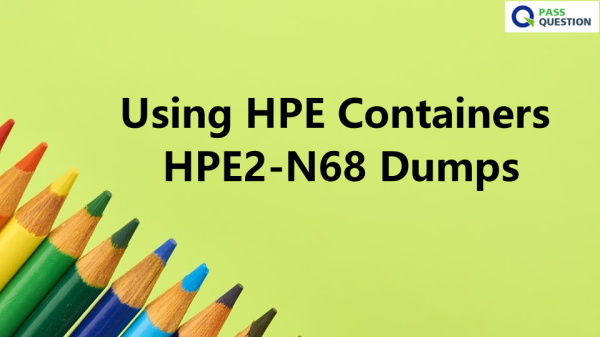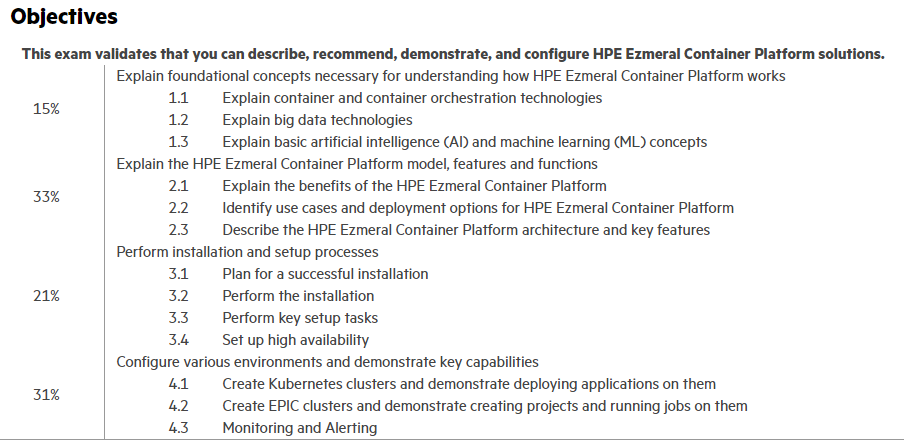Using HPE Containers HPE2-N68 Dumps
If you are looking for HPE2-N68 Using HPE Containers exam preparation, PassQuestion has the latest Using HPE Containers HPE2-N68 Dumps in order to help you memorize and pass your exam at very first attempt. We are offering all the high quality Using HPE Containers HPE2-N68 Dumps that you can use to prepare for the real exam. It is highly recommended to go through all of our HPE2-N68 questions and answers so you can achieve the best results and clear the Using HPE Containers exam on the first attempt. With the help of our Using HPE Containers HPE2-N68 Dumps, you will be able to get a clear idea of the real exam scenario.

Using HPE Containers -HPE Product Certified - Containers [2021]
HPE Product Certified - Containers [2021] certification validates that you can describe, recommend, demonstrate, and configure HPE Ezmeral Container Platform solutions.
- Explain foundational concepts necessary for understanding how HPE Ezmeral Container Platform works.
- Explain the HPE Ezmeral Container Platform model, features, and functions.
- Perform installation and setup processes.
- Configure various environments and demonstrate key capabilities.
Ideal candidate
Typical candidates for this certification are HPE customers, partners, and employees who configure, implement, support, and use HPE Ezmeral Container Platform solutions.
The minimally qualified candidate will have basic industry standard knowledge and skills related to containers. They will have some familiarity with the HPE product portfolio.
Exam Information
Exam ID: HPE2-N68
Exam type: Web based
Exam duration: 1 hour 30 minutes
Exam length: 40 questions
Passing score: 70%
Delivery languages: Korean, Japanese, English
Exam Objectives

View Online Using HPE Containers HPE2-N68 Free Questions
How are resources allocated to EPIC virtual nodes?
A.Tenant Admins create and edit flavors to define resource requests, and Tenant Members select the flavors for virtual nodes they create.
B.The platform provides three default flavors to define how resources are allocated, and only Site Admins can edit those flavors.
C.Site Admins use templates to define resources tor virtual nodes, and Tenant Admins can edit these templates.
D.Tenant Admins create and edit templates to define how resources are allocated, and Tenant Members can view, use, and edit those templates.
Answer:B
A company IT department has strict requirements around data protection and wants you to explain how to use the Max Target and Mm Target options for an HPE Ezmeral Data Fabric volume.
What should you explain?
The Max Target sets the desired RAID level for data In the primary volume. The Mm Target sets the desired RAID level for data In associated mirror and snapshot volumes.
A.The Max Target sets the desired number of replicas for data; the Min Target sets a replica number at which the fabric still tries to reach the Max Target, but less aggressively.
B.The Max Target and Min Target work together to set the erasure coding level for data in the volume. C. The Max Target is the total number of blocks and the Min Target is the total minus redundant blocks.
C.The Max Target sets the desired number of replicas for "hot" (frequently used) data; the Min Target sets the desired number of replicas for "warm" (less frequently used) data.
Answer:C
You have created a Data Fabric-type Kubernetes cluster on Ezmeral Container Platform. You want to use this cluster's Data Fabric to provide persistent storage for other Kubernetes clusters on the platform.
This storage should include automatically generated TenantShares and TenantStorages.
What should you do?
A.Set the platform's Tenant Storage to HDFS mode; specify the IP address of the Data Fabric cluster's conductor (master) in the HDFS settings.
B.Re-run the Ezmeral Container Platform installation file, selecting the "--upgrade" option, and select the embedded Data Fabric option.
C.Reference the Data Fabric cluster as the underlying cluster for every Kubernetes Tenant that you create.
D.Use scripts on the controller to prepare, configure, and register the Data Fabric cluster as the Tenant Storage.
Answer:A
You have added a deployment object to the "tenant!" namespaces on a Kubetnetes cluster using the "cluster.local" domain name.
The deployment's pods run a Web-based application. You want the application running on these pods to be accessible within the cluster at hostname:
portaLtenantl.svc.clusteUocal.
Which object meets these requirements?
A.A service object with ClusterIP type and name "portal"
B.A replica set object with container ports 80 and 443
C.A configmap object with ports 80 and 443 and name "portaLtenant l"
D.A kdcluster object with hostname "portal.tenantl.svc.cluster.local"
Answer:A
What is a setting that you are allowed to change after you deploy a Kubernetes cluster?
A.The number of hosts assigned to a role
B.The type (data fabric or non-data fabric)
C.The pod network range
D.The authentication settings
Answer:A
- TOP 50 Exam Questions
-
Exam
All copyrights reserved 2025 PassQuestion NETWORK CO.,LIMITED. All Rights Reserved.

